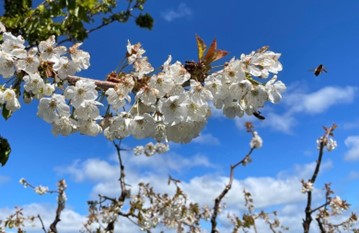In cool spring, bees struggle to pollinate Northwest cherry crop

Seattle Times staff reporter
HOOD RIVER, Oregon — Grower Brad Fowler walked into the cherry orchard on yet another May day when the temperatures struggled to climb above 50 degrees and a chill wind swept through the long rows of trees at the tail end of their annual bloom.
Fowler searched for signs of honeybees doing the vital work of pollination that sets fruit as they move from blossom to blossom. On a warm day, he might find 20 bees in each tree, their flights creating a steady hum. On this morning, there was an unsettling quietness. He could only find a few bees spread about the trees he examined.
“I am surprised they are out at all, as cold as it is,” Fowler said.
Here in the Hood River valley in northern Oregon, and all throughout the prime Pacific Northwest cherry-growing regions, the cool spring weather has often kept the bees — billions of which are brought into the region’s fruit orchards each year — inside, or close by, the hives of their wooden box colonies.
The low temperatures have resulted in slower and later flowering of the cherry trees. In some orchards, when temperatures prime for bee flight finally arrived, the window for blossom pollination had already closed.
B. J. Thurlby, president of Northwest Cherry Growers, says the challenges in pollinating this crop, along with damage from the cold, are expected to reduce this year’s cherry crop by 35% compared with the average volume of the past five years.








